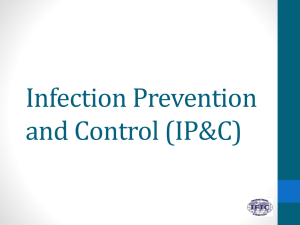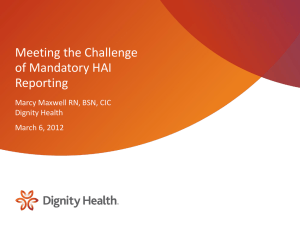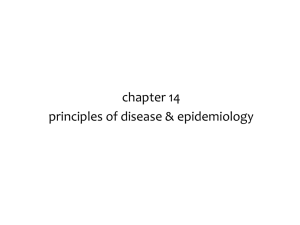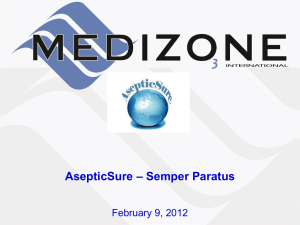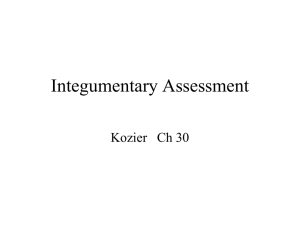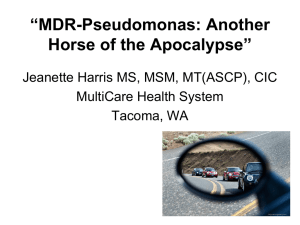Management of Specific Infectious Complications in Children with
advertisement
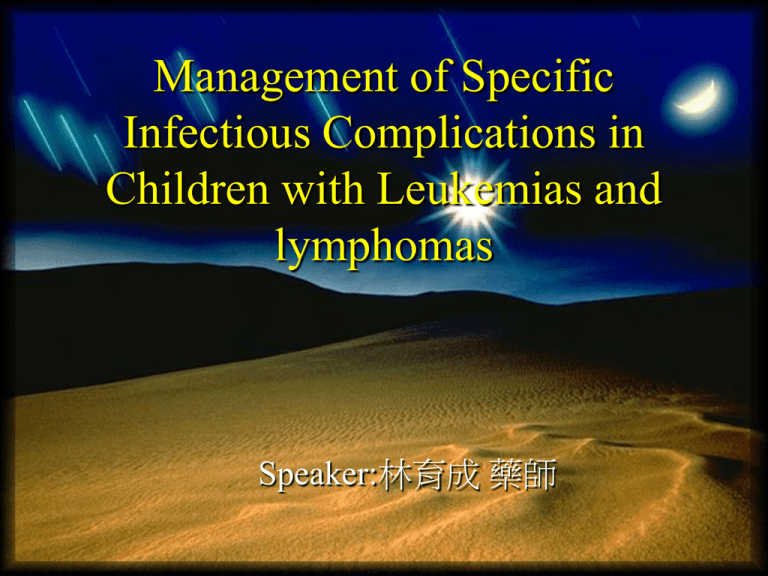
Management of Specific Infectious Complications in Children with Leukemias and lymphomas Speaker:林育成 藥師 Introduction (1) Childhood cancer is the secondary cause of death in children <15 years old Leukemia and lymphoma constitute approximately 50% of new diagnosed childhood cancer Maintenance regimens may last 1-3 years, prolonging the period of immunosuppression and continuing the risk for infection Introduction (2) The magnitude of risk of infection varies closely with the depth and duration of granulocytopenia Low-risk acute lymphocytic leukemia high-risk acute lymphocytic leukemia Introduction (3) Patients who receive chemotherapy Fever evidence of infection Neutropenia<1 week Fewer than 30% Fewer than 30% Neutropenia>1week Almost 100% Almost 100% fever Fever : the most important indicator of infection in children with cancer Infectious and noninfectious cause Child’s underlying malignancy (Ewing sarcoma) The production of pyrogens (e.g.. Certain lymphoma) Most fevers in children with cancer are associated with granulocytopenia and infection. Granulocytopenia Important risk factor associated with infection. The depth and duration of granulocytopenia is directly related to the frequency of serious infections Defects in chemotaxis, generation of superoxide, phagocytosis, and bactericidal activity in vitro. Granulocytopenia Abnormally reduced number of granulocytes circulating in peripheral blood Absolute neutrophil count (ANC)<1,000 cells/mm ^3 indicates a reduction sufficient to predispose patients to infection ANC: absolute numbers of both mature neutrophils and immature neutrophils (PMN, also called “polys” or “seg”) “bands” Absolute neutrophil count ANC 500~1,000 <500 (cell/mm^3) <100 Risk of infection and death +++ + ++ Important risk factors for infections (1) Rate of neutrophil decline Duration of neutrpenia Important risk factors for infections (2) ANCs falling rapidly, <500/mm^3 within 24 hours severe neutropenia Severe neutropenia > 7~10 days’ duration high risk Leukemia patient with relapsing disease are at increased risk of infection, even in the absence of neutropenia Factors contributing to the risk of infection (1) Abnormalities in mucosal and integumentary physical defense Decreases in phagocyte numbers and functions Profound alterations in cellular and humoral immune defenses Alterations in innate recognition immunity Alterations in endogenous microbial flora Factors contributing to the risk of infection (2) Exposure to new potential pathogens secondary to treatment with cytotoxic and antimicrobial agents Intravascular devices Hospitalization Alteration of nutrition Glucocorticosteroids Decrease neutrophil migration, phagocytosis, and intracellular microbicidal activity Alter macrophage function, diminishing host defenses against tissue-invasive fungi and other pathogens, including intracellular bacteria, protozoan, and virus. Glucocorticosteroids Aggrevated cell-mediated immunity defects, making patients even more susceptible to infections Varicella-zoster virus [VZV];Herpes simplex virus [HSV];Cytomegalovirus [CMV] fungal [pneumocystosis, cryptococcosis, histoplasmosis] Antineoplastic agents that decrease phagocytic and bactericidal activity Vinca alkoids L-asparaginase 6-mercaptopurine methotrexate anthracyclines Cytotoxic chemotherapy and radiation therapy Diminish B-cell functions, Leading to decreased immunoglobulin concentrations Lowered opsonic activity Inadequate agglutination and lysis of bacteria Deficient neutralization of bacterial toxins. Immunoglobulin deficiency Susceptibility of encapsulated bacteria Markedly increased risk for Haemophilus influenzae type B and pneumococcal blood stream infections Cytocotoxic chemotherapy v.s. Vaccine Depressed the responses to common antiviral and antibacterial vaccines: both primary and booster challenges Defective antibody production (for up to 5 years after completion of anticancer therapy) Depending on underlying malignancy, doseintensity of antineoplastic chemotherapy, and the vaccine used Spleen If spleen is infiltrated by leukemia and lymphoma or removed for diagnostic or therapeutic reasons, the risk of fulminant infection from such encapsulated bacteria as Streptococcus pneumoniae, H. influenzae, and Neisseria meningitidis is consideralby increased. Candida spp. Colonization by Candida spp.is also common, in particular in patients receiving broad -spectrum antibiotics . Management of specific infectious complications (1) Prompt use of appropriate antimicrobial therapy Modifications of antimicrobial therapy Adding anaerobic coverage for necrotizing gingivitis or perirectal cellulitis Adding vancomycin for G(+) infections caused by coagulase-negative staphylococci Management of specific infectious complications (2) In patients with prolonged neutropenia: addition of antifungal therapy Bloodstream infections Between 10%~20% of febrile and neutropenic cancer patients have a bacteremia. Sources of bacteremia lung (25%), perioral cellulitis (10%), gastrointestinal tract (5%), indwelling intravascular devices (increasing frequency) Common antibacterial agents (1) Piperacillin: Broad G(-) spectrum (particularly, Pseudomonas aeruginosa); active against anaerobe, enterococci. In neutropenic patients, use only in combination with an aminoglycoside Daily dose: 200-300 mg/kg in 4-6 divided doses (max. 21g) Common antibacterial agents (2) Ceftazidime : Broad G(-) spectrum, including P. aeruginosa; limited G(+) spectrum; no activity against anaerobes. Combination with an aminoglycoside recommended for G(-) bacteremia Daily doses:60-100 mg/kg in 3 divided doses (max.6g) Ceftriaxone: option for empiric therapy in nonneutropenic patients with an indwelling central vvenous catheter; no coverage of P. aeruginosa Daily doses :75-100 mg/kg in 1 single dose Common antibacterial agents (3) Imipenem: Broad G(-) and G(+) spectrum, including P. aeruginosa; broad antianaerobic activity. Combination with an animoglycoside is recommended for treatment of P. aeruginosa infections ( Daily dose: 50 mg/kg in 4 divided doses , max. 4g) Aztreonam: Exclusive G(-) spectrum including many strains of P. aeruginosa. Options for combination therapy with vamcomycin (±aminoglycoside) in patients with -lactam allergy. (Daily dose: 100-150 mg/kg in 4 divided dose, max. 6g) Common antibacterial agents (4) Vancomcycin: Spectrum limited to G(+) bacteria. Monitoring of serum levels required with vancomycin (Daily dose: 40 mg/kg in 2-4 divided doses, max. 2g) Gentamicin: Combinatory agent for empiric therapy and for treatment of documented G(-) infections, monitoring of serum levels required. (Daily dose: 5 mg/kg in 1 or 3 divided doses) Common antibacterial agents (5) Metronidazole: active against anaerobes (abdominal/perirectal processes); first choice for treatment of Clostridum difficlile infection (PO) (Daily dose: 30mg/kg in 4 divided doses, max. 4g) Erythromcyin: Therapy for proven/suspected infections by Chlamydia, Mycoplasma, and Legionella (30-50 mg/kg in 4 divided doses, max. 4g) Catheter-Associated Bloodstream Infections Transiently placed and permanent central venous catheters led to an increase in catheter-associated bacteremias Diagnosis: blood cultures from both a catheter lumen (+); a peripheral venous site (+) When is catheter removal required? Blood cultures remain positive for more than 24 to 48 hours after antibiotics have been started A “tunnel infection” ( tenderness or induration along the subcutaneous track of the catheter) exists Detection of Candida spp. and other yeasts in blood cultures Fungal pneumonia Aspergillus spp. : The most frequent primary respiratory fungal pathogens in cancer patient C. albicans and non-albicans Candida species: The most common yeast like pathogens in pediatric cancer patients and can cause primary pneumonia Upper Respiratory tract infections Otitis sinusitis epiglottitis Lower Respiratory Tract Infections Patch infiltrates in non-neutropneic children Patch infiltrates in neutropenic children Diffuse infiltrates in neutropenic children Diffuse infiltrates in non-neutropenic children Nocardia Infection Nocardia species ( Nocardia asteroides and Nocardia brasiliensis) main portal entry: respiratory tract Main clinical manifestation: focal pulmonary infection 30 % of patients with Nocardia pneumonia have subcutaneous abscess and brain abscesses Treatment of Norcardia infection Sulfadiazine or TMP/SMX Combination of imipenem-cilastatin If the patient is unable to tolerate or does not respond to sulfonamide: amoxicillinclavulanic acid plus amikacin Fungal pneumonias Infections by Histoplasma capsulatum, Coccidioides immitis, and Blastomyces dermatitidis In severely immunocomprosmised cancer patients: cause invasive and often dissemianated diseases that are lifethreatening Approaches to antifungal therapy for fungal pneumonias Amphotericin B deoxycholate : all mycoses; 0.5~1.0 mg/kg/day Itraconazole : histoplasmosis and blastomycosis; 5~12 mg/kg/day Fluconazole: coccidioidomycosis; 8~12 mg/kg/day Pneumocystis carinii and Protozoal Pneumonia P. carinii and the protozoal organism Toxoplasmosis gondii and S. steroralis can cause diffuse infiltrates in both neutropenic and non-neutropenic patients. PCP has decreased with the introduction of prophylactic TMP/SMX Pneumocystis carinii and Protozoal Pneumonia Children with hematologic malignanies who are receiving dose-intensive antineoplastic chemotherapy are at high risk for development of life-threatening Pneumocysitis carnii pneumonia Prophylactic TMP/SMX Viral pneumonias (1) Adenovirus measles RSV Parainfluenza CMV Varicella Viral pneumonias (2) Ganciclovir: does not appear to improve the outcome of fully developed CMV pneumonia in allogeneic bone marrow transplantation patients, although some what better responses have been obtained with a combination of ganciclovir and intravenous anti-CMV immunoglobulin. Daily dose: 10mg/kg in 2 divided doses Viral pneumonias (3) CMV: found in the urine or saliva of 27% of children with leukemia CMV: cause gastrointestinal, hepatosplenic, chorioretinal, CNS, pulmonary, and disseminated disease Pneumonitis: the most common manifestation of CMV disease in the cancer setting Viral pneumonias (4) Primary varicella in the child with cancer has a natural mortality rate of 7% to 20% if untreated Acyclovir 500mg/square meter of body area every 8 hours Acyclovir therapy appeared to be effective even in children with varicella who has already developed pulmonary infiltrated when treatment as initiated. Infections of Orointestinal Tract S-phase specific chemotherapeutic agents: e.g. methotrexate, cytosine arabinoside, 5fluorouracil Mucositis Oral Mucositis Associated with chemotherapy Sometimes be exceedingly severe, requiring TPN and patient-directed continuous analgesia with morphine derivatives Mouth-cleansing solutions help decrease the discomfort and control superinfection Treatment of oral candidiasis Oral clotrimazole troches: 50mg five times daily fluconazole :3-6mg /kg/day cyclodextrin-itraconazole: 5 day/kg/day intrvaenous amphotericin B: 0.5mg /kg or less per day for 5days Oral HSV infection Acyclovir orally (for patient can reliably swallow these pills) Acyclovir intravenous Chronic Disseminated (“Hepatosplenic”) Candidiasis Chronic disseminated candidiasis (CDC) CDC is an uncommon but potentially lifethreatening condition in patients with cancer Develops during prolonged granulocytopenia but usually becomes apparent only on recovery from granulocytopenia. Chronic Disseminated (“Hepatosplenic”) Candidiasis Preferentially affects the liver and spleen. Characteristics: persistent fever despite granulocyte recovery right upper quadrant abdominal pain Serum alkaline phosphatase levels ( ) Approaches to management of hepatosplenic candidiasis Amphotericin B +flucytosine Amphotericin B lipid complex, followed by long-term fluconazole for susceptible isolates Fluconazole (intolerant or refractory to amphotericin B) Antifungal therapy is recommended until resolution or calcification of lesions (6 mon~1 year) Perirectal cellulitis Perirectal cellulitis:can be a problem in children with prolonged, profound granulocytopenia The risk of perirectal cellulitis increase if perirectal mucositis, hemorrhoids, fissure, or rectal manipulation has occurred. Treatment of perirectal cellulitis Begin early with antibiotics to cover aerobic gram-negative bacilli, anaerobes, and group D streptococci, stool softerners, and lowresidue diet Genitourinary infections Infections of the genitourinary tract are uncommon in children with cancer unless obstruction by tumor, catheterization, neurologic dysfunction Pathogens: Gram-negative aerobic bacilli and enterococci Treatment: amphotericin B plus flucytosine or fluconazole for probable renal candidiasis Cutaneous infections Bacterial skin infections include common local gram(+) infections, Starting at sites of invasive devices or skin breaks, wounds, radiation, burns, or furuncles (especially in patients receiving glucocorticosteroids) Cutaneous infections P. aeruginosa, can cause fulminant local infection , Embolic or vasculitic-appearing lesions can be seen with bacteremia caused by P. aeruginosa, Aeromonas hydrophilus, Corynebacterium equi, or S. marcescens. Cutaneous infections :VZV Primary varicella: the most serious vesicular eruption in children with cancer High rate of visceral dissemination and considerable mortality If seronegative patient exposed to VZV, immuoprophylaxis with VZV immune globulin should be given intravenously no later than 72 hours after the exposure Cutaneous infections:VZV The patient should not receive immunosupressive therapy for approxiamtely 21 days after exposure, and not until scabs heal over if disease develop. Central nervous system infections Meningitis Encephalitis Encephalitis Encephalitis : generally rare Cause: usually caused by HSV, VZV, or measles Differential diagnosis: neoplastic, toxic , metabolic cause Encephalitis If one or more enhancing lesion are seen in the brain, Toxoplasma should be condsidered. pyrimethamine and sulfadiazine or TMP/SMX 本院目前使用中之抗黴菌藥物比較表 Diflucan Cancidas Fungizone Ambisome 商品名 Fluconazole Caspofungin Amphotericin B Liposomal 成分 amphotericin B yes yes yes yes 注射劑 yes No No No 口服劑 100mg 50mg 50mg inj:595 50mg inj : 健保價 inj:695 inj:12236 6641 150mg tab:280 50mg tab:109 yes yes yes 抗菌活性 yes Candida Cryptocc yes No yes yes ocus Aspergill No yes yes (not good ) yes ( high us dose) Scedopori No No No No um Fusarium No No No No 595 19923~39846 平均每日 注射劑:9788 12236 藥價 口服劑:2808 Reference Clinical management of infections in immunocompromised infants and children. Andreas H. Groll. Management of specific infectious complications in children with leukemias and lymphomas, 2001. P111-143 Pharmacotherapy, a pathophysiologic approach. Infection in immunocompromised patients. Fifth edition, Douglas N. Fish, Infections in immunocompromised patients 2089-2109 Thanks for your attention!
